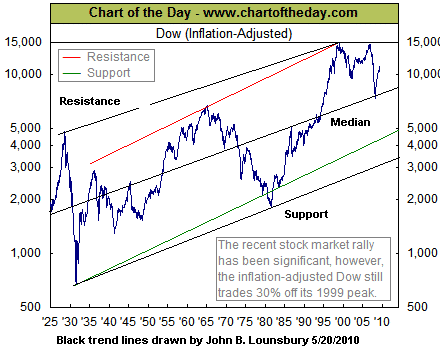Expecting A Range Bound Market For 2010 Unless We Double Dip
I have posted the chart below from Chart of the Day before. The previous time I pointed out that there are three super cycles in the chart and the current super cycle is much different from the two previous ones if March 9, 2009 was the super cycle low. Click here to see how that was illustrated.
Today I want to ask a different question. If March 9, 2009 was not the super cycle low, what is the potential bottom for the trading range based on market trends for the past 100 years? The same graph with different annotation is used for that purpose:
The black median, support and resistance lines have been drawn using the 1932 and 1982 bottoms for support and the 1929 and 2000 tops for resistance. The Chart of the Day folks have chosen two other lines to define the trading channel.
There is nothing magical about selecting the very best support and resistance lines. Any method must be considered a rough approximation and definitely so when each line is defined by only two points. Also, penetration of support and resistance (and also failure to reach either one) are common occurrences.
All that said, this technique is good for assessing ballpark potentialities. This graph is telling us that the bottom potential for the market over the next five years is between 3,000 and 5,000 on the Dow (2010 dollars).
To repeat, support and resistance are not laws of nature. For example, the cycle lows in the late 1930s and 1940s were well above support. But they did get into the lower half of the trading range. The low in 2009 barely touched the mid-point of the trading range.
Some may consider this exercise trivial. Perhaps it is. Perhaps this time is different. But, on prior occasions, many have lived to rue the day when they assumed this time is different. Always consider the possibilities just in case this time is not different.
My analysis based on fundamentals has me expecting a trading range market for the Dow in 2010 (9,500 to 11,500). And 2011 probably still range bound between 9,000 and 12,000. This is based on the achievement of a modest economic recovery (GDP growth 2% to 2.5% annual rate average over the next 7-8 quarters). Higher GDP growth rates should easily push the Dow well over 12,000 before the end of 2011.
A double dip into recession would probably see the Dow drop below 9,000, but, absent a depressionary panic, I think revisiting the March 9, 2009 is unlikely. Thus my estimate of the probability of getting close to the 5,000 region for the Dow is very low, certainly less than 5%.
The more optimistic are welcome to point out that the top of the trading range is now off the chart with resistance in the 20,000 to 25,000 range over the next five years. I think the probability of hitting 20,000 or higher on the Dow by 2015 is also very low, even though we are now comfortably in the upper half of the chart.
John Lounsbury provides comprehensive financial planning and investment advisory services to a small number of families on a fee only basis. He has a background which includes 34 years with a major international corporation, 25 years in R&D management and corporate staff positions. Since 2002 he has operated his own sole proprietorship business. John is also one of the top ten authors at Seeking Alpha and a featured commentator at TheStreet.com Real Money.

That’s quite a trading range, 9000 to 12000 through 2011, 4 standard deviations! Thanks a lot! I know what to expect now.